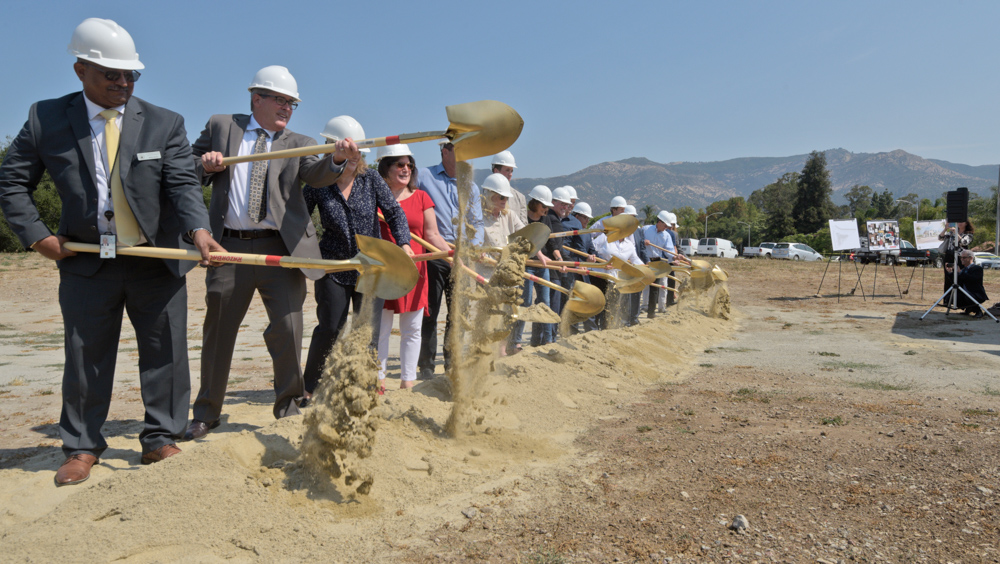
Dignitaries and political big shots donned white ceremonial hard hats under a blazing Monday morning sky, picked up 20 gold-plated ceremonial shovels, and dug up 20 spades of ceremonial sand hauled to the site just for the occasion. The actual ground is way too hard for anything less than jackhammers. If all goes according to plan, the site — a triangular parcel of nearly two acres, located on Hope Avenue along the backside of La Cumbre Plaza — will soon be occupied by 90 new low-income rental units affordable to tenants with incomes ranging between $17,000 and $35,000 a year.
Studio units at what the Housing Authority of the City of Santa Barbara has dubbed “The Gardens on Hope” will be small — about 330 square feet — but rents will be decidedly low, ranging from $474 to $938. The project, developed by the Housing Authority, will target low-income senior citizens. Residents can be provided three meals a day, transportation, and housekeeping services, though they will cost extra.
To hear Housing Authority czar Rob Fredericks tell it, The Gardens on Hope managed to dodge a few serious bullets along the way. Other affordable housing projects might not be so lucky. First there are Santa Barbara’s escalating land costs to contend with. Fredericks said the Housing Authority managed to buy the land for $2.5 million in 2013. Just a few months ago, Fredericks said the same chunk of rock-hard dirt was appraised at $5 million. Partially responsible for this manic market is City Hall’s AUD — Average Unit-Size Density — program, which rewards rental-housing developers with sky-high densities. This in turn has sparked such a frenzy for AUD-eligible parcels that the Housing Authority now finds itself priced out.
While other AUD developments have generated significant controversy — the higher densities, fewer parking spaces required, and smaller unit sizes have not yet translated into the “affordable-by-design” rents the program’s supporters promised — Fredericks stressed that 100 percent of the units built on Hope Avenue will be affordable. They will also be intensely subsidized. Without such subsidies, Fredericks said he’d have to charge $2,000-$2,500 a month just to break even.
And since Donald Trump has occupied the White House, Fredericks said, these low-income-housing subsidies have come under sustained attack. The tax-reform package Trump signed last year, Frederick said, seriously undermined investor interest in low-income-housing tax credits. Without wealthy investors buying these government-sanctioned tax credits, he said, there’s little capital to build affordable housing. Fredericks said tax-credit sales generated $16 million of the $29 million it will cost to build the new Hope Avenue units. When Trump signed the tax reform package last year, the value of tax credits tanked and the Housing Authority’s then-prospective financial partner Union Bank stopped pursuing the deal. In Union’s stead, the Housing Authority signed a partnership deal with Enterprise Equity Investments, which Fredericks praised to the sky. The Trump administration and its housing secretary, Dr. Ben Carson, have proposed other significant cuts to other federal affordable-housing subsidies. Carson, for example, has proposed stiffer work requirements for Section 8 housing vouchers. He’s also proposed changes that would require recipients to pay more of their housing costs out of pocket, in some categories tripling it.
Congressmember Salud Carbajal, one of the event’s featured speakers and a vociferous critic of Trump, took delight in reporting that Congress successfully rebuffed Trump’s efforts to cut back such housing programs. He took even greater delight reporting Congress actually voted to increase funding by 10 percent.
According to Fredericks, the average household costs for the average South Coast senior are $2,400 a month, 20 percent higher than the statewide average. Many seniors, he said, are forced to make do on only $910 a month, their Social Security stipend. Of the 1,300 people on the Housing Authority’s waiting list, he said, 933 are seniors. The new housing project is scheduled to take 14 months to construct.
This story has been corrected to reflect that Union Bank did not back out of the deal so much as lose interest in it.



